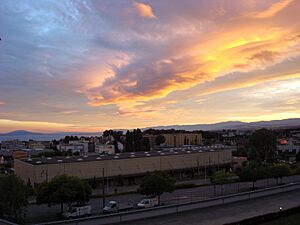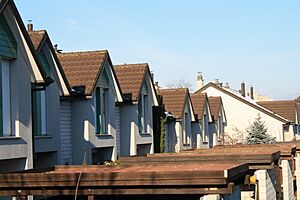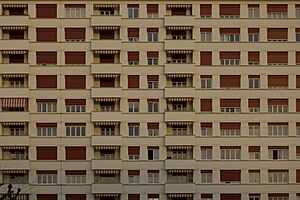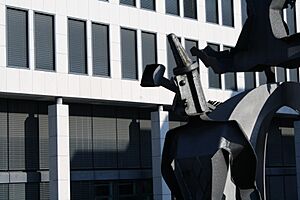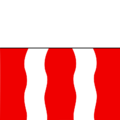Renens facts for kids
Quick facts for kids
Renens
|
||
|---|---|---|
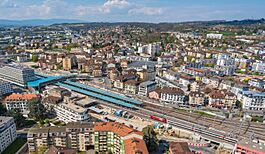
Aerial view of Renens
|
||
|
||
| Country | Switzerland | |
| Canton | Vaud | |
| District | Ouest Lausannois a | |
| Area | ||
| • Total | 2.95 km2 (1.14 sq mi) | |
| Elevation | 415 m (1,362 ft) | |
| Population
(Dec 2020 )
|
||
| • Total | 20,834 | |
| • Density | 7,062/km2 (18,291/sq mi) | |
| Demonym(s) | Les Renanais | |
| Postal code |
1020
|
|
| Surrounded by | Lausanne, Crissier, Prilly | |
| Twin towns | Dietikon (Switzerland) | |
Renens is a lively town in the canton of Vaud, Switzerland. It's a suburb of the bigger city of Lausanne. Renens is the fourth largest city in its canton. It's known for being very diverse, with over half of its residents coming from about 100 different countries!
History of Renens: A Journey Through Time
Renens was first mentioned a very long time ago, between the years 888 and 896. Back then, it was called Runingis. People have found ancient tombs from the Stone Age (Neolithic period) and graves from the early Middle Ages in the area.
Who Owned Renens in the Past?
In the Middle Ages, the church leaders of Lausanne Cathedral owned Renens. Later, between 1233 and 1303, they created a special church position there. In 1555, a person named Claude de Praroman traded some land to get control of Renens. The house he already owned became his castle, known as Chateau de Renens.
The city of Lausanne bought the lordship of Renens in 1750. The castle was sold again in 1752 and passed through several families over the years. There are even stories that the famous composer Mozart might have stayed in this castle when he visited Lausanne!
From Village to City: How Renens Grew
At that time, Renens was still a small village. A few families owned much of the land. One important place was the 'Renens-sur-Roche' castle, built in the 18th century. Another was the 'Ferme des Tilleuls' (Lime Tree Farm), built in the early 1700s.
Renens officially became its own municipality in 1798. This meant it could govern itself. From 1901, it had its own local council. In the 1950s, Renens grew big enough to be called a city. In 2006, it became the main town of the West-Lausanne district.
Geography: Where is Renens Located?
Renens covers an area of about 2.96 square kilometers (1.14 square miles). A small part of this land, about 3.4%, is used for farming. About 2.4% is covered by forests. Most of the land, around 93.9%, is developed with buildings and roads.
What is Renens Land Used For?
Looking closer at the developed areas:
- About 13.9% is for industrial buildings.
- About 41.6% is for homes and other buildings.
- About 28.7% is for transportation like roads.
- About 3.4% is for power and water facilities.
- About 6.4% is for parks, green spaces, and sports fields.
The municipality is the capital of the new Ouest Lausannois district. It is part of the larger Lausanne city area.
Getting Around: Transportation in Renens
Renens has good transport links. The Lausanne Métro line 1 ends at the Renens railway station. The Swiss Federal Railway also connects Renens directly to Lausanne and other cities. Renens is also close to major highways, making it easy to travel by car.
Coat of Arms: The Symbol of Renens
The official symbol of Renens, its coat of arms, is described as: Gules, two Pales wavy Argent, Chief of the same. This means it has a red background with two wavy silver stripes, and a silver top section.
Population: Who Lives in Renens?
Renens has a population of about 18,511 people. More than half of the people living in Renens, about 51.2%, are foreign nationals. This makes Renens a very diverse and multicultural place.
Languages Spoken in Renens
In 2000, most people in Renens spoke French (about 73.8%). The second most common language was Italian (6.6%), followed by Portuguese (4.4%). A smaller number of residents spoke German.
Where People Come From
About 16.3% of the people in Renens were born there. Another 24.1% were born in the same canton (Vaud). About 13.9% were born elsewhere in Switzerland. A large number, about 42.7%, were born outside of Switzerland.
Population Growth Over Time
The population of Renens has grown a lot over the years. In 2008, more non-Swiss citizens were born in Renens than Swiss citizens. Also, more non-Swiss people moved to Renens than Swiss people. This shows that the foreign population in Renens is growing.
Age Groups in Renens
In 2009, about 10.9% of the population was under 9 years old. About 11.0% were between 10 and 19. The largest group, about 16.2%, was between 20 and 29 years old. This means Renens has a relatively young population.
Households and Homes
In 2000, there were about 8,196 households in Renens, with an average of 2.2 people per household. Many households (38.2%) had only one person. There were also many married couples, both with and without children.
Most of the buildings in Renens are homes. In 2000, about 41.3% were single-family homes, and 34.2% were multi-family buildings (like apartment blocks). Many of these buildings were built between 1946 and 1960.
Historical Population Data
The chart below shows how Renens' population has changed over time:

Economy: How People Work in Renens
In 2010, the unemployment rate in Renens was 7.6%. This means that 7.6% of people who wanted to work couldn't find a job.
Jobs in Different Sectors
Most jobs in Renens are in the service sector. This includes jobs like sales, transportation, hotels, finance, and healthcare.
- Only a few people work in the primary sector (like farming).
- About 2,338 people work in the secondary sector. This includes jobs in manufacturing and construction.
- About 7,493 people work in the service sector.
Many people travel into Renens for work. In 2000, about 7,789 workers came into the municipality, while 7,087 left to work elsewhere. This means Renens has more jobs than local workers. Many people use public transportation (31.7%) or private cars (49.8%) to get to work.
Religion: Faith in Renens
Based on the 2000 census, many different religions are practiced in Renens.
- About 44.3% of the population were Roman Catholic.
- About 21.5% belonged to the Swiss Reformed Church.
- Other Christian groups, like Orthodox churches, made up about 4.02%.
- About 9.03% of the population were Muslims.
- Smaller numbers of people were Buddhist, Hindu, or Jewish.
- About 10.34% of the population did not belong to any church or had no specific religion.
Education: Schools and Learning in Renens
Many people in Renens have a good education. About 30.0% of the population have finished high school (upper secondary education). About 9.0% have gone on to higher education, like a university or a specialized college.
School System in Renens
In the 2009/2010 school year, there were 2,355 students in the Renens school district.
- Children can attend two years of non-required pre-school.
- Primary school lasts for four years.
- Lower secondary school is required for six years.
- Some students are homeschooled or attend other types of schools.
Many students who live in Renens attend schools outside the municipality (about 1,188 students). Also, 93 students from other towns come to school in Renens.
Notable People from Renens
Renens has been home to or associated with several interesting people:
- Fabio Celestini (born 1975): A Swiss professional football player and manager. He played for FC Renens and later became its trainer and president.
- Henri Dès (born 1940): A famous French-language children's singer and songwriter. He was born in Renens.
- Bigambo Rochat (born 1991): A Swiss football player.
- Alfred Stucky (1892–1969): A Swiss dam engineer who started his engineering company in Renens in 1926.
- Frédéric Veseli (born 1992): An Albanian professional football player.
Images for kids
See also
 In Spanish: Renens para niños
In Spanish: Renens para niños





